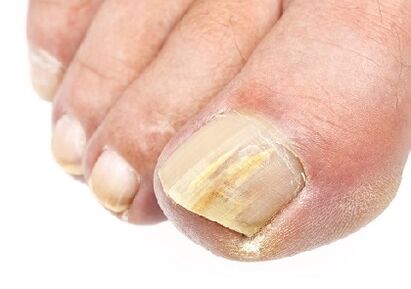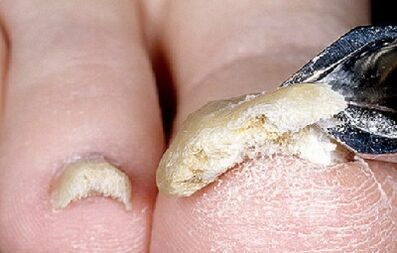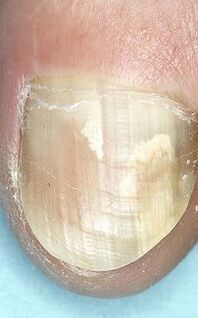Like what toenail fungus, symptoms and treatment Every third person on earth has faced problems such as the removal and crushing of nails, plate closure - this is onychomycosis. The disease strikes a variety of ages. Nail fungus (pictured below) spreads quickly and adapts to new conditions.
Every third person on earth has faced problems such as the removal and crushing of nails, plate closure - this is onychomycosis. The disease strikes a variety of ages. Nail fungus (pictured below) spreads quickly and adapts to new conditions.
Consider in more detail the main factors of occurrence, types and methods of treating fungus at home.
Welding
The causative agents of this disease are saprophytes, fungi, candida and other pathogenic microorganisms.
Main pathogen types:
- Epiderrnophyton floccosum. Anthropophilic fungi that affect the stratum corneum of the epidermis. After infection, pink flaky spots with special blurred edges begin to appear on the skin. Sending via tactile touch or via household items.
- Trichophyton rubrum and Trichophyton mentagrophytes. These are two yeast -like fungi of the genus Trichopyton. They have toxic effects, they can stay inactive for a long time, and after exposure to negative factors, they become more active. The first signs of the disease are itching between the fingers and an unpleasant odor, then a rash and peeling appear. The color of the integument may not change.
Mycologists distinguish four types of mycosis, which can be caused by various foot fungi:
- The deleted form is the lightest. It is characterized by slight itching between the fingers and slight peeling of the skin. The reason is Candida saprophyte. The incubation period is 2 weeks. Often, patients are unaware of the signs of infection and spread of the fungus. Although there is no treatment, the disease goes away on its own.
- Squamous-hyperkeratotic. This neglected form of foot fungus can cause the appearance of cracks and damage to the tissues of the foot up to the ankle. It should be noted that in the early stages of the disease there are no external manifestations. The soles are not itchy and not painful, sometimes small cracks appear;
- Intertriginous or interdigital is the most common. Often, the primary lesion begins with the folds of the thumb and forefinger, then spreads along the foot. Possible causes - contact with infected people (surfaces), injuries and non -compliance with the rules of personal hygiene;
- Dyshidrotic or vesicular form - mycosis, which provokes the appearance of local rashes and erosions on the epidermis. It is transmitted exclusively from patients and is rarely diagnosed on the skin of the feet. It is believed that this fungus prefers on the hands and palms. In the absence of proper treatment, mycotic eczema occurs due to exposure to pathogenic microorganisms.
Over time, fungal infections develop, although this happens very slowly. Sometimes people live with the fungus for decades and start to worry only when the nails are really gone, a painful sensation appears. There are several levels in total.
- Early stage. A new fungal infection begins to destroy the nail, its color changes, its transparency disappears.
- The appearance of hyperkeratosis. This phenomenon, when, with mycosis, the nails begin to thicken, become very dense, sometimes growing strongly. At the end of this stage, the nail plate becomes loose, sometimes the top layer can only be scraped off with a finger.
- In the next stage, the fungal infection moves under the nail. The cuticle detaches from the nail plate, and the nail folds can become red, swollen and inflamed.
- The stage is running. Nails atrophy, it changes color completely. At this stage, the nail plate is often missed or completely destroyed.
It is recommended to suspect nail fungus at an early stage, in its advanced form it is difficult and long to treat, sometimes it is necessary to remove the nail plate completely. Do not start mycosis.
Symptoms
Onychomycosis most often affects toenails, more rarely the hands. The disease begins with the thumb and little finger (outer edge affected), smoothly affecting all plates.
The main symptoms of onychomycosis will help determine the fungal infection:
- the appearance of lines and spots of whitish or greenish color under the nails;
- obscure the plate, change its color (from yellow to dark brown);
- redness and peeling of the skin around the nails;
- appearance of roughness on the feet and between the toes;
- mold formation on nails.
To learn how to recognize the disease at an early stage, you can see the main manifestations of nail fungus in the photo. This will allow you to at least understand how the progression of the infection begins, and if you find similar signs, see a doctor.
What does the fungus look like in the photo
In any case, the initial examination of the foot was performed independently. In order not to confuse the fungus with the possibility of corns or common mechanical damage to the feet, we recommend that you review photos of nail fungus at an early and advanced stage.
In order not to confuse the fungus with the possibility of corns or common mechanical damage to the feet, we recommend that you review photos of nail fungus at an early and advanced stage.

Diagnostics
There are more than 50 subspecies of fungi that cause onychomycosis, so it is possible to determine its type accurately only in laboratory conditions. Early diagnosis at home is possible from the second stage, when symptoms appear.
- It is necessary to examine the nail plate to determine the localization of the fungal infection.
- The next criteria are the form of changes in nail thickness, the presence of flaking and crumbling scales.
- The determining factor may be the color of the focus of the infection.
- It is necessary to assess the condition of the skin and hair at the time of detection of onychomycosis: many fungi attack them first, and then turn to the nail plate.
In some cases, the causative agent is some type of fungal infection. Combination of dermatophytes with fungi such as yeast or fungi with candida is possible.
Treatment of nail fungus in the early stages

If such a disease occurs, 3 treatment options are possible, all depending on the stage at which the fungus is located. So this:
- use of local remedies;
- use of oral medications;
- joint therapy.
Local remedies are represented by various ointments, gels, suspensions, emulsions and other types of external preparations. They act only on the focus of the lesion and do not penetrate the bloodstream. They are used mainly in the early stages of the development of dermatomycosis or with a small focus of infection. Treatment, as a rule, ranges from a week to several months, depending on the degree of neglect of the lesion.
- Oral medications are taken orally and act on the causative agent from within the body. They have side effects, and affect not only the affected area, but also the body as a whole. In some cases, one application is sufficient, sometimes treatment is required. They are used for severe wounds and advanced fungal diseases.
- Combination therapy is used more frequently. The action of external drugs reduces the intensity of symptoms, accelerates the healing of the damaged area, and the tablets act internally on the causative agent of the disease.
With any treatment option, the course of therapy should not be interrupted. The drug use regimen and duration are determined by the doctor. As a rule, treatment is continued after the disappearance of symptoms and external manifestations of mycoses for several more days (up to a week).
Varnishes and ointments against fungus
If nail fungus is not started, but in the early stages, it is a good idea to try varnishes and ointments that help soften the affected area. In this case, the fungal spores die under the influence of the drug.
- The most common antifungal varnishes are "Terbinafin", "Amorolfin", "Cyclopirox". Following the instructions, the varnish is applied twice a week for several months, until healthy nails grow back completely.
- Also known to many: creams - "Sertaconazole", "Bifonazole", "Ketoconazole", "Terbinafine"; spray - "Terbinafine", etc. Apply on a clean, dry surface to the area of fingers and nails affected by the fungus. Antifungal liquids containing boric acid and resorcinol help dry and disinfect the affected skin and nails.
- Antiseptics made on the basis of iodine, accelerate the process of renewal and healing of the nail itself and the surrounding area. After using the spray, manifestations of allergic reactions in the form of burning, itching may occur.
For nail treatment, you should choose one type of medication. Not recommended to change, change funds, such manipulation will lead to a decrease in the effectiveness of the therapeutic effect. Before starting use, be sure to read the contraindications. Pregnant women, children and people with individual intolerance are prohibited from using antifungal varnish for treatment.
Before applying the varnish or ointment, the area of the nail affected by the fungus should be removed as much as possible using a special file that came with the medication. After cleaning the nails with a water-alcohol solution, a layer of varnish is applied, which must be replaced every few days. Before the procedure, you can take a soap and soda foot bath. Varnish is removed in the same way as decoration, using organic solvents.
ethnoscience
Nail mycosis in the early stages can be treated with home methods. Folk remedies are good helpers in the complex therapy of this disease.

- Sea salt. This drug is combined with conservative treatment. Sea salt bath is a recommended preparatory procedure before applying topical products. For a small amount of hot water, you need to take a tablespoon of salt, take care of your feet for about 15-20 minutes.
- Trays of decoction of willow branches are used 3 times a week. To cook, collect the young shoots, finely chop, take 500 gr. raw material and pour 2 liters of water. Boil, reduce heat and hold for 10 minutes. Once the broth has cooled, strain it and leave on the feet for 20 minutes.
- The essential oil. Injured nails should be lubricated before bed, bandaged and left overnight. In the morning, remove the bandage, clean the stratum corneum of the nail and drip more tea tree oil, but do not wrap it. It is important to continue treatment until healthy nails begin to grow.
- Vinegar bath. In 2 liters of hot water (37 degrees), dilute 5 tbsp. l. Vinegar 9%. The feet must be soaked in such a solution for at least half an hour. Next, clean the softened keratin layer of the nail with a fingernail, and treat the affected part of the foot and between the toes with pumice stone. After such manipulation, it is recommended to use a cream or antifungal solution. Perform the procedure regularly (1-2 times a day) for a month.
- Celandine. This plant has long been used to fight nail and skin diseases. It must be handled with caution because of its active "cauterizing" effect. Celandine juice, decoctions and oils based on this plant are used to fight fungi.
Laser therapy
Laser therapy is one of the newest treatments for nail fungus, especially at an advanced stage. This method is an alternative to surgical removal, followed by a long recovery period. During laser treatment, healthy tissue is not touched; during the procedure, the patient does not experience pain or other unpleasant sensations.
Disadvantages of laser treatment: high price, you have to rest between procedures, can only be done by a qualified dermatologist. Regardless of the method of therapy chosen, it is very important to follow all the rules of personal hygiene. Nail fungus can recur and treatment will not be effective if not done.
While treating toenail fungus, you need to perform regular hygiene procedures, often change socks, ventilate shoes after wearing. The same rules must be followed so that nail mycosis does not arise again after treatment.
prevention
Of course, it is better to prevent fungus than to deal with its consequences for a long time.
How to protect yourself from fungus:
- At the first signs of fungus (itching, redness, flaking), you need to gently lubricate the feet with salicylic ointment. It has a strong antibacterial effect and moisturizes the skin. Conversely, chamois or streptocide are also suitable;
- Before each visit to the pool, sauna, gym or other place where you need to take off shoes, it is important to treat your feet with a protective cream.
- Treat shoes regularly, wash if possible and dry outside. There is no need to use a special formula for this. A large number of products can be cleaned from the inside with alcohol or other antibacterial solutions.
To strengthen the skin and ensure local immunity, recipes for prophylactic mixtures based on onions are suitable. An onion is ground with two tablespoons of honey. The resulting paste is rubbed on the skin of the feet and palms. It is best to keep the mask on for 30 minutes. Repeat daily;
















